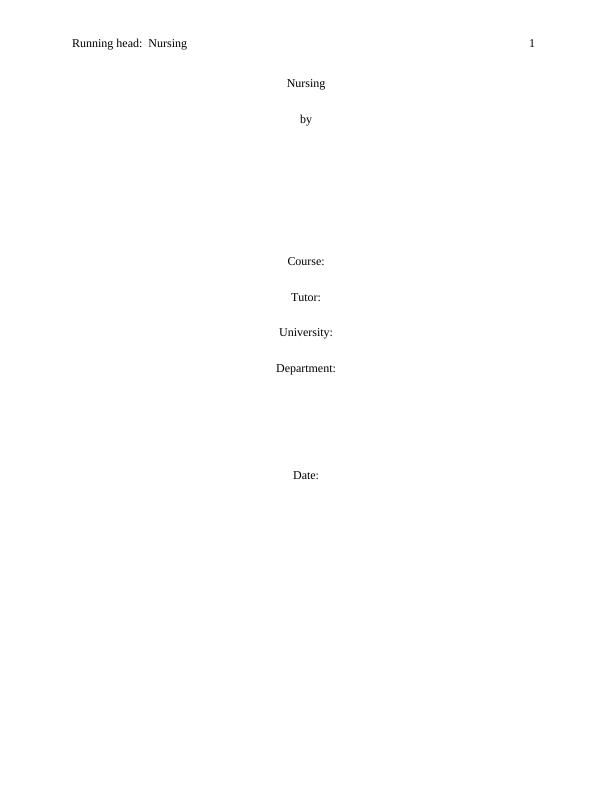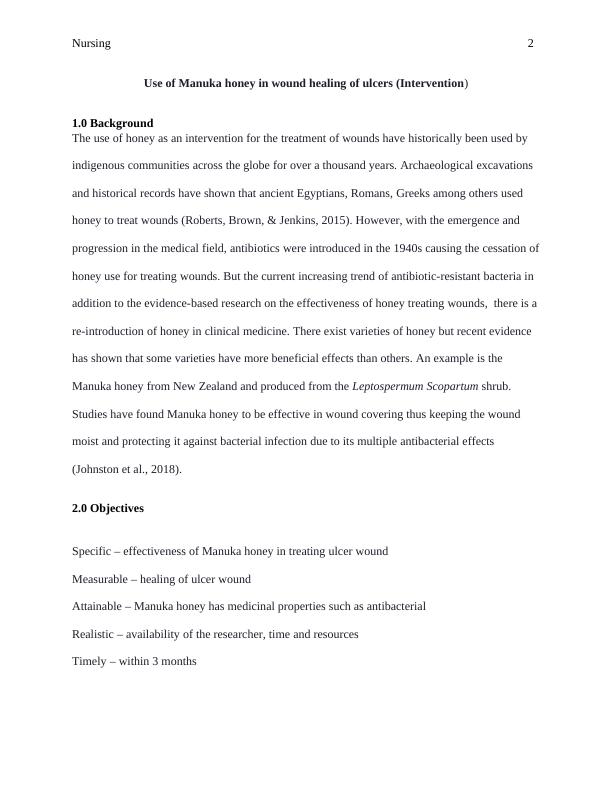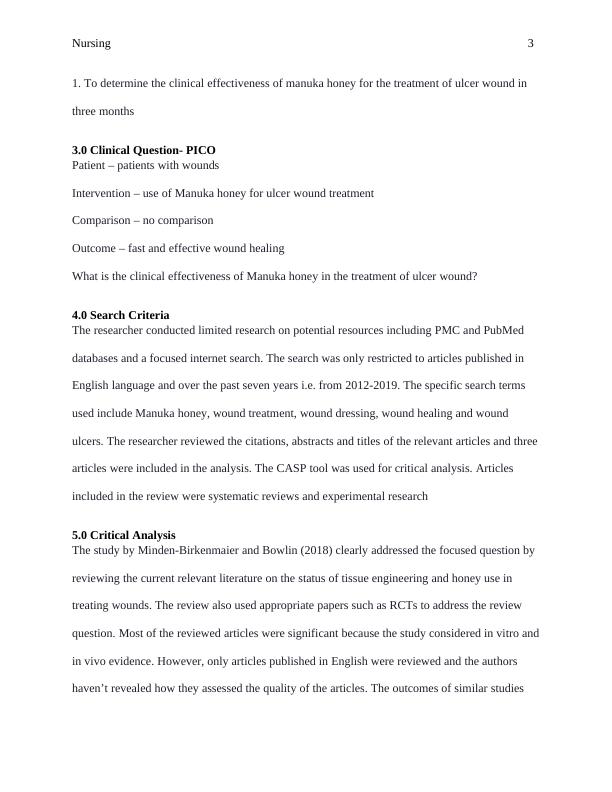Use of Manuka Honey and Leg Wrapping in Wound Healing
Added on 2022-10-03
13 Pages2781 Words164 Views
Running head: Nursing 1
Nursing
by
Course:
Tutor:
University:
Department:
Date:
Nursing
by
Course:
Tutor:
University:
Department:
Date:

Nursing 2
Use of Manuka honey in wound healing of ulcers (Intervention)
1.0 Background
The use of honey as an intervention for the treatment of wounds have historically been used by
indigenous communities across the globe for over a thousand years. Archaeological excavations
and historical records have shown that ancient Egyptians, Romans, Greeks among others used
honey to treat wounds (Roberts, Brown, & Jenkins, 2015). However, with the emergence and
progression in the medical field, antibiotics were introduced in the 1940s causing the cessation of
honey use for treating wounds. But the current increasing trend of antibiotic-resistant bacteria in
addition to the evidence-based research on the effectiveness of honey treating wounds, there is a
re-introduction of honey in clinical medicine. There exist varieties of honey but recent evidence
has shown that some varieties have more beneficial effects than others. An example is the
Manuka honey from New Zealand and produced from the Leptospermum Scopartum shrub.
Studies have found Manuka honey to be effective in wound covering thus keeping the wound
moist and protecting it against bacterial infection due to its multiple antibacterial effects
(Johnston et al., 2018).
2.0 Objectives
Specific – effectiveness of Manuka honey in treating ulcer wound
Measurable – healing of ulcer wound
Attainable – Manuka honey has medicinal properties such as antibacterial
Realistic – availability of the researcher, time and resources
Timely – within 3 months
Use of Manuka honey in wound healing of ulcers (Intervention)
1.0 Background
The use of honey as an intervention for the treatment of wounds have historically been used by
indigenous communities across the globe for over a thousand years. Archaeological excavations
and historical records have shown that ancient Egyptians, Romans, Greeks among others used
honey to treat wounds (Roberts, Brown, & Jenkins, 2015). However, with the emergence and
progression in the medical field, antibiotics were introduced in the 1940s causing the cessation of
honey use for treating wounds. But the current increasing trend of antibiotic-resistant bacteria in
addition to the evidence-based research on the effectiveness of honey treating wounds, there is a
re-introduction of honey in clinical medicine. There exist varieties of honey but recent evidence
has shown that some varieties have more beneficial effects than others. An example is the
Manuka honey from New Zealand and produced from the Leptospermum Scopartum shrub.
Studies have found Manuka honey to be effective in wound covering thus keeping the wound
moist and protecting it against bacterial infection due to its multiple antibacterial effects
(Johnston et al., 2018).
2.0 Objectives
Specific – effectiveness of Manuka honey in treating ulcer wound
Measurable – healing of ulcer wound
Attainable – Manuka honey has medicinal properties such as antibacterial
Realistic – availability of the researcher, time and resources
Timely – within 3 months

Nursing 3
1. To determine the clinical effectiveness of manuka honey for the treatment of ulcer wound in
three months
3.0 Clinical Question- PICO
Patient – patients with wounds
Intervention – use of Manuka honey for ulcer wound treatment
Comparison – no comparison
Outcome – fast and effective wound healing
What is the clinical effectiveness of Manuka honey in the treatment of ulcer wound?
4.0 Search Criteria
The researcher conducted limited research on potential resources including PMC and PubMed
databases and a focused internet search. The search was only restricted to articles published in
English language and over the past seven years i.e. from 2012-2019. The specific search terms
used include Manuka honey, wound treatment, wound dressing, wound healing and wound
ulcers. The researcher reviewed the citations, abstracts and titles of the relevant articles and three
articles were included in the analysis. The CASP tool was used for critical analysis. Articles
included in the review were systematic reviews and experimental research
5.0 Critical Analysis
The study by Minden-Birkenmaier and Bowlin (2018) clearly addressed the focused question by
reviewing the current relevant literature on the status of tissue engineering and honey use in
treating wounds. The review also used appropriate papers such as RCTs to address the review
question. Most of the reviewed articles were significant because the study considered in vitro and
in vivo evidence. However, only articles published in English were reviewed and the authors
haven’t revealed how they assessed the quality of the articles. The outcomes of similar studies
1. To determine the clinical effectiveness of manuka honey for the treatment of ulcer wound in
three months
3.0 Clinical Question- PICO
Patient – patients with wounds
Intervention – use of Manuka honey for ulcer wound treatment
Comparison – no comparison
Outcome – fast and effective wound healing
What is the clinical effectiveness of Manuka honey in the treatment of ulcer wound?
4.0 Search Criteria
The researcher conducted limited research on potential resources including PMC and PubMed
databases and a focused internet search. The search was only restricted to articles published in
English language and over the past seven years i.e. from 2012-2019. The specific search terms
used include Manuka honey, wound treatment, wound dressing, wound healing and wound
ulcers. The researcher reviewed the citations, abstracts and titles of the relevant articles and three
articles were included in the analysis. The CASP tool was used for critical analysis. Articles
included in the review were systematic reviews and experimental research
5.0 Critical Analysis
The study by Minden-Birkenmaier and Bowlin (2018) clearly addressed the focused question by
reviewing the current relevant literature on the status of tissue engineering and honey use in
treating wounds. The review also used appropriate papers such as RCTs to address the review
question. Most of the reviewed articles were significant because the study considered in vitro and
in vivo evidence. However, only articles published in English were reviewed and the authors
haven’t revealed how they assessed the quality of the articles. The outcomes of similar studies

Nursing 4
were combined and those with different outcomes compared. The current study is beneficial in
epidemiological studies because it shows the recent technological advancement in the treatment
of wounds using Manuka honey. However, its reliability, strength and validity are relative.
Clark and Adcock (2018) also conducted a literature review to find out the evidence on wound
treatment using honey. The review question was clearly addressed because the study provides a
detailed research methodology used in the study. Moreover, the right papers were used in the
review because the PICO format was used as a selection criterion. The authors assessed the
quality of the studies by subjecting them to a standard inclusion and exclusion criteria.
Moreover, the results have been compared with previous studies. The study was beneficial
because it gave evidence on the benefit of honey in treating wounds. Therefore, the validity,
reliability and strength of the study were high.
An RCT was carried out by Tsang et al. (2017) to ascertain whether Manuka honey was more
useful in wound dressing of a diabetic foot ulcer in comparison with the usual treatment. There
was low-quality randomization during the allocation of patients to treatments and then analyzed.
The treatment was blinded and equal in the two groups and the participants were similar at the
commencement of the study
There is overwhelming evidence on the efficacy using Manuka honey in wound healing because
it fights bacteria, eliminates chronic inflammation, and fosters faster wound treatment. It is more
effective in fighting strains of resistant bacteria where conventional medicine has failed. This is
due to its contents such as MRSA that is responsible for fighting bacteria. It is also important in
most of the tissue engineering templates
6.0 Recommendations
6.1 Practice
were combined and those with different outcomes compared. The current study is beneficial in
epidemiological studies because it shows the recent technological advancement in the treatment
of wounds using Manuka honey. However, its reliability, strength and validity are relative.
Clark and Adcock (2018) also conducted a literature review to find out the evidence on wound
treatment using honey. The review question was clearly addressed because the study provides a
detailed research methodology used in the study. Moreover, the right papers were used in the
review because the PICO format was used as a selection criterion. The authors assessed the
quality of the studies by subjecting them to a standard inclusion and exclusion criteria.
Moreover, the results have been compared with previous studies. The study was beneficial
because it gave evidence on the benefit of honey in treating wounds. Therefore, the validity,
reliability and strength of the study were high.
An RCT was carried out by Tsang et al. (2017) to ascertain whether Manuka honey was more
useful in wound dressing of a diabetic foot ulcer in comparison with the usual treatment. There
was low-quality randomization during the allocation of patients to treatments and then analyzed.
The treatment was blinded and equal in the two groups and the participants were similar at the
commencement of the study
There is overwhelming evidence on the efficacy using Manuka honey in wound healing because
it fights bacteria, eliminates chronic inflammation, and fosters faster wound treatment. It is more
effective in fighting strains of resistant bacteria where conventional medicine has failed. This is
due to its contents such as MRSA that is responsible for fighting bacteria. It is also important in
most of the tissue engineering templates
6.0 Recommendations
6.1 Practice

End of preview
Want to access all the pages? Upload your documents or become a member.
Related Documents
HLSC122 | Pico Analysis In Nursinglg...
|5
|1258
|135
Critical Assessment of Research Articles on Honey as a Treatment for Bacterial Wound Infectionslg...
|12
|3315
|88
PUBH6005 : Epidemiology PDFlg...
|12
|3253
|212
PUBH6005 : Epidemiology PDFlg...
|13
|4193
|85
Honey Dressing for Wound Healing in Diabetic Patients: A PICO(t) Analysislg...
|23
|2202
|374
Honey Dressing for Diabetic Foot Ulcers: A Critical Appraisallg...
|8
|1569
|178
